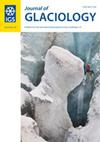多晶温带冰渗透率与液态水含量的关系
IF 2.6
3区 地球科学
Q2 GEOGRAPHY, PHYSICAL
引用次数: 0
摘要
为了更好地约束温带冰川的融水输送和冰粘度,特别是在冰流剪切边缘,我们使用一个定制的渗透率仪来研究温带冰的渗透率与其液态水含量之间未经检验的模型关系。测量了两种平均粒径(1.8 mm和4.2 mm)的实验室制冰的渗透率,并用冰的盐度控制其含水量,并进行了量热测量。在实验结束后,将荧光素染料添加到流动的冷冻水中,以突出通过冰的流动路径。正如一个简单模型所预测的那样,渗透率大约随含水量的平方而增加,在含水量为0.1-4.4%的范围内,渗透率增加了约三个数量级。然而,细冰和粗冰的渗透率值分别比模型的平均值小2.6和4.1倍。这种差异可能是由于静脉弯曲、截断或空气堵塞。测量值和模拟值之间的数量级一致可能表明,这些因素导致的渗透率降低几乎被孤立或乔木状的超大矿脉中的优先流动所补偿。这两种优先流动路径都被观察到,但后者仅在含水量>的细粒冰中被观察到;2%。本文章由计算机程序翻译,如有差异,请以英文原文为准。
The relationship between the permeability and liquid water content of polycrystalline temperate ice
To better constrain meltwater transport and ice viscosity in temperate glaciers, particularly in ice stream shear margins, we use a custom permeameter to study the untested model relationship between the permeability of temperate ice and its liquid water content. The permeability of lab-made ice of two mean grain diameters (1.8 and 4.2 mm) is measured, and water content is controlled with the ice salinity and measured calorimetrically. Fluorescein dye is added to through-flowing, chilled water to highlight flow pathways through the ice after experiments. As predicted by a simple model, permeability increases with approximately the square of the water content and by about three orders of magnitude across water contents of 0.1–4.4%. However, permeability values are less than those of the model by average factors of 2.6 and 4.1 for the finer and coarser ice, respectively. This discrepancy is likely due to tortuous, truncated or air-clogged veins. The order-of-magnitude agreement between measured and modeled values may indicate that reduced permeability from these factors is nearly compensated by preferential flow in oversized veins that are isolated or arborescent. Both kinds of preferred flow pathways are observed but the latter only in fine-grained ice at water contents > 2%.
求助全文
通过发布文献求助,成功后即可免费获取论文全文。
去求助
来源期刊

Journal of Glaciology
地学-地球科学综合
CiteScore
5.80
自引率
14.70%
发文量
101
审稿时长
6 months
期刊介绍:
Journal of Glaciology publishes original scientific articles and letters in any aspect of glaciology- the study of ice. Studies of natural, artificial, and extraterrestrial ice and snow, as well as interactions between ice, snow and the atmospheric, oceanic and subglacial environment are all eligible. They may be based on field work, remote sensing, laboratory investigations, theoretical analysis or numerical modelling, or may report on newly developed glaciological instruments. Subjects covered recently in the Journal have included palaeoclimatology and the chemistry of the atmosphere as revealed in ice cores; theoretical and applied physics and chemistry of ice; the dynamics of glaciers and ice sheets, and changes in their extent and mass under climatic forcing; glacier energy balances at all scales; glacial landforms, and glaciers as geomorphic agents; snow science in all its aspects; ice as a host for surface and subglacial ecosystems; sea ice, icebergs and lake ice; and avalanche dynamics and other glacial hazards to human activity. Studies of permafrost and of ice in the Earth’s atmosphere are also within the domain of the Journal, as are interdisciplinary applications to engineering, biological, and social sciences, and studies in the history of glaciology.
 求助内容:
求助内容: 应助结果提醒方式:
应助结果提醒方式:


